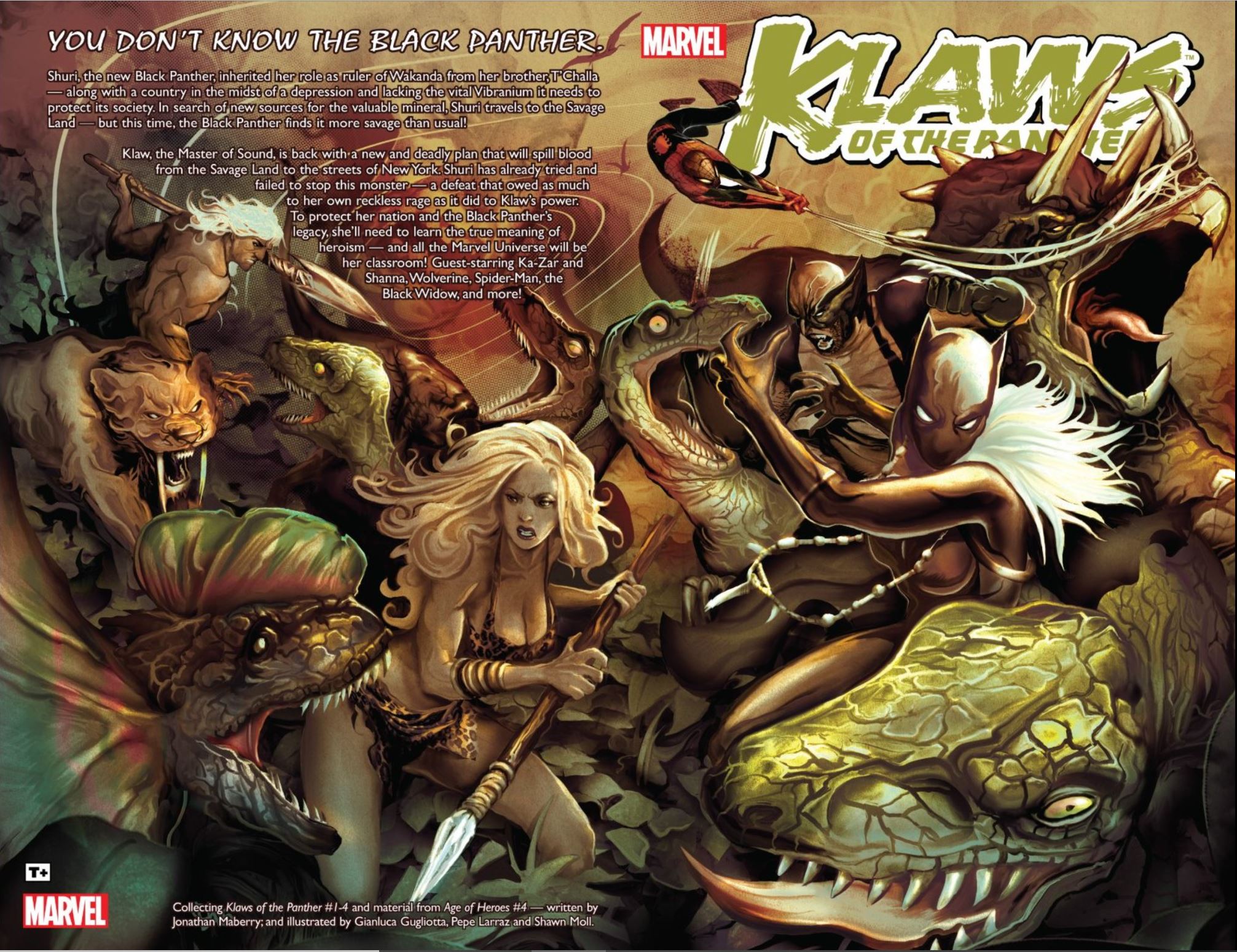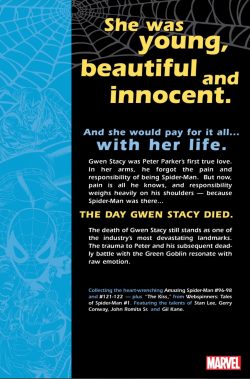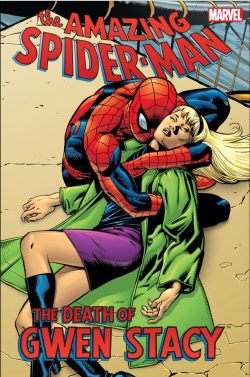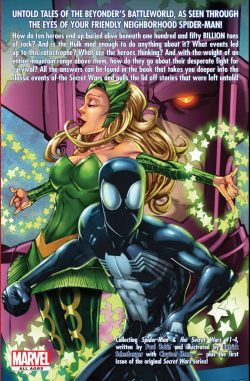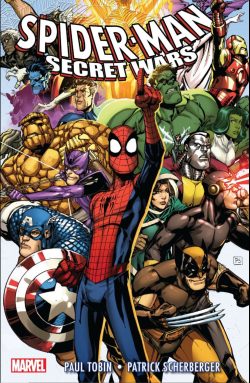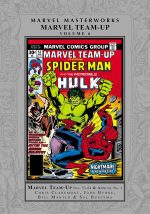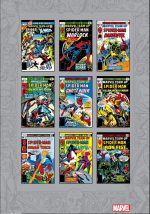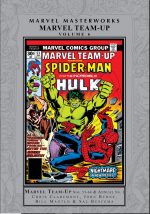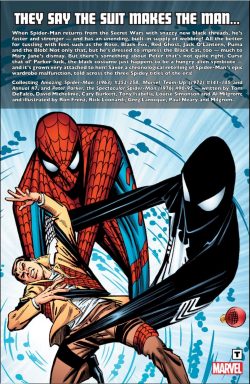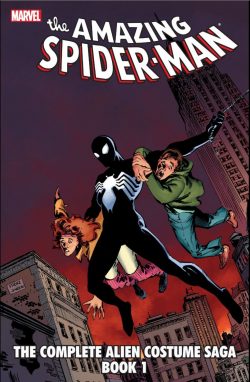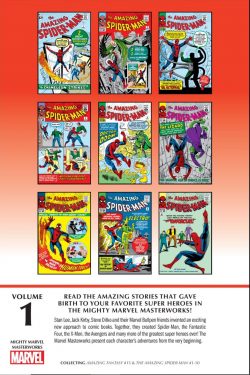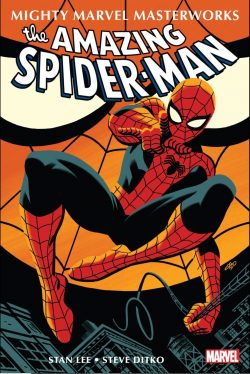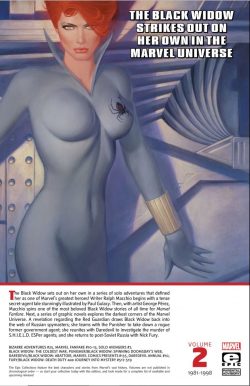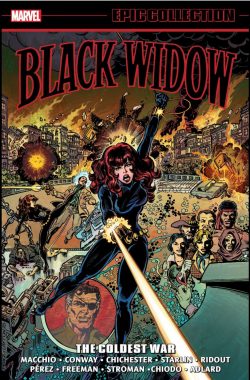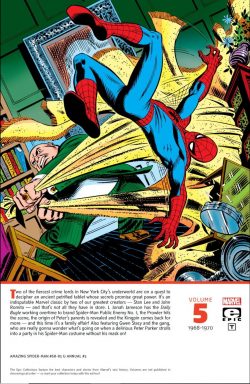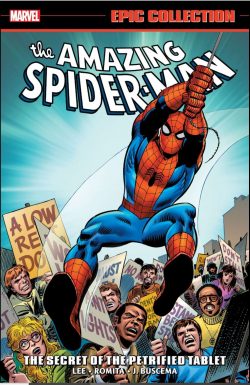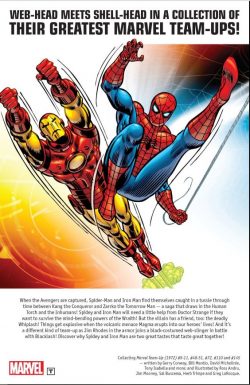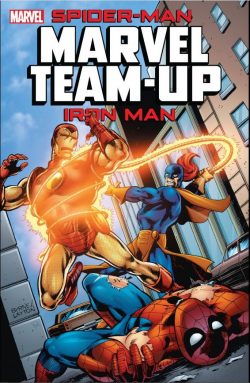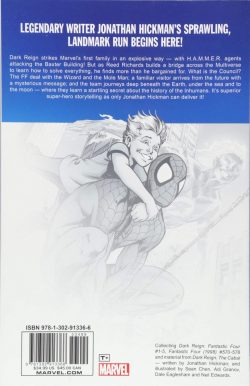
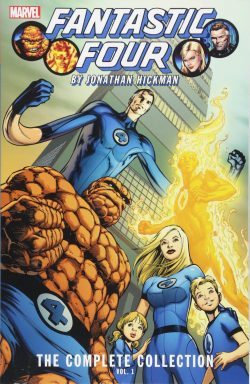
By Jonathan Hickman with Sean Chen, Lorenzo Ruggiero Adi Granov, Dale Eaglesham, Neil Edwards, Andrew Currie, Paul Neary, Scott Hanna & various (Marvel)
ISBN: 978-1-3029-1336-6 (TPB)
Win’s Christmas Gift Recommendation: World’s Greatest Comic Conceptualists… 9/10
The Fantastic Four is generally considered the most pivotal series in modern comic book history, introducing both a new style of storytelling and a decidedly different manner of engaging the readers’ impassioned attentions.
More family than team, the roster has changed continuously over the years but always returning to the original configuration of Mister Fantastic, Invisible Woman, the Thing and Human Torch, who together formed the vanguard of modern four-colour heroic history.
The quartet are also known as maverick genius Reed Richards, his wife Sue, their trusty college friend Ben Grimm and Sue’s obnoxious younger brother Johnny Storm; driven survivors of an independently-funded space-shot which went horribly wrong after Cosmic Rays penetrated their ship’s inadequate shielding.
When they crashed back to Earth, the foursome found that they had all been hideously mutated into outlandish freaks. Richards’ body became elastic, Sue gained the power to turn invisible and, eventually, project force-fields, Johnny could turn into living flame, and poor, tormented Ben was mutated into a horrifying brute who, unlike his comrades, could not return to a semblance of normality on command.
The series has always been more about big ideas than action/adventure, and that was never more true than in this compilation when the FF were steered by writer, artist designer and stellar modern imagineer Jonathan Hickman (Nightly News; Pax Romana; East of West; Infinity; House of X; Secret Wars).
This chronological compilation opens during the Dark Reign that followed a successful conquest of Earth, when the draconian Federal mandate known as the Superhuman Registration Act led to Civil War between costumed heroes. Tony Stark was hastily appointed the US government’s Security Czar – a “top cop†in sole charge of the beleaguered nation’s defence and freedom. As Director of high-tech enforcement agency S.H.I.E.L.D. he became the very last word in all matters involving metahumans and the USA’s vast costumed community…
Stark’s subsequent mismanagement of various crises led to the arrest and assassination of Captain America and an unimaginable escalation of global tension and destruction, culminating in the Secret Invasion by shape-shifting alien Skrulls. Discredited and ostracised, he was replaced by apparently rehabilitated, recovering schizophrenic Norman Osborn – the original Green Goblin – who assumed full control of the USA’s covert agencies and military resources, disbanded S.H.I.E.L.D. and placed the nation under the aegis of his own new organisation H.A.M.M.E.R.
The erstwhile villain had first begun his climb back to respectability after taking charge of the Thunderbolts Project: a penal program which offered a second chance to super-criminals who volunteered to undertake Federally-sanctioned missions…
Not content with legitimate political and personal power, Osborn also secretly conspired with a coalition of major malevolent masterminds to divvy up the world between them. The Cabal was a Star Chamber of super-villains working towards mutually self-serving goals, but such egomaniacal personalities could never play well together for long and cracks soon began to show, both in the criminal conspiracy and Osborn himself…
As another strand of his long-term plan, the Homeland Metahuman Security overlord fired Iron Man‘s Mighty Avengers and created his own, more manageable team consisting of compliant turncoats, tractable replacements and outright impostors. Constantly courting public opinion, Osborn launched his Avengers whilst systematically building up a personally loyal high-tech paramilitary rapid-response force.
During this Dark Reign, the rapidly destabilising madman – through means fair and foul – officially worked to curb the unchecked power and threat of meta-humanity, whilst his clandestine cabal of dictators divvied up the planet between them. The repercussions of Osborn’s rise and fall were felt throughout and featured in many series and collections covering the entire Marvel Universe.
Reed Richards had been a major supporter of Stark and key proponent of the Superhuman Registration Act even though his actions tore his family apart; driving his wife Sue and brother-in-law Johnny Storm into the opposing camp of costumed resistors dubbed the Secret Avengers. His best friend Ben Grimm – unwilling to choose sides – left the country to become an exile in France…
This collection opens with 5-issue miniseries Dark Reign: Fantastic Four and portions of Dark Reign: The Cabal (spanning May to September 2009): exploring and explaining Mister Fantastic’s side of the argument, as well as the terrifying motivations which prompted his uncharacteristic behaviour even as the still-wounded family painfully try to reconcile in their old home The Baxter Building……
The drama begins with a prelude a week after the Skrull invasion as Earth’s greatest mind constructs a colossal interdimensional transit threshold. ‘The Bridge’ – illustrated by Sean Chen & Lorenzo Ruggiero – is a pathway to alternate Earths. Demoralised and confused, Richards wants to explore all the other Earths to see if the Civil War and subsequent tragedies which followed happened elsewhere and how a plurality of other Mr. Fantastics dealt with it.
He needs to know how to prevent such a catastrophe ever happening again, but only just convinces Sue, Ben and Johnny that he must go before the metaphorical roof caves in…
Acting with sublime overconfidence and seemingly blessed by good fortune, Osborn chooses that moment to invade the Baxter Building with his H.A.M.M.E.R. troops, determined to shut down the Fantastic Four and confiscate all their incredible technologies.
Outraged and ready for trouble, Invisible Woman, the Torch and the Thing head for the ground floor just as Osborn’s men cut power to the building. The resultant surge in energy interacts with Reed’s Bridge and collapses space-time. When the elevator doors open they find themselves in another realm: a primitive jungle where men, dinosaurs and space gods co-exist…
With the adults out of action, children Franklin and Valeria take charge of the situation, bluffing the H.A.M.M.E.R. heavies into leaving, but little Val knows it’s only a matter of time until Osborn comes in person. She might be only three, but she’s already as smart as her father…
Setting to, Val begins repairing the building’s electrical and defence systems even as somewhen else her devoted guardians battle hordes of time-lost terrors and, in a region where all places meet, her dad views universe after universe and sees few happy outcomes…
As hours pass in the normal world, Sue, Johnny and Ben are bounced from one bizarre alternity to the next, gradually gathering a stout band of like-minded heroes about them.
In fact they are strange variations of themselves: a gentle, noble erudite Thing, chamberlain to the court of the Virgin Queen; a blazing pirate Torch on a flying galleon, sharp-shooting sheriff Black Susan from an extremely wild, Wild West frontier town and so many more, all assisting as they determinedly fight their way to somewhere they can get home from…
After a night on their own, Val and Franklin are awoken by Security Czar Osborn and his forces, accompanied by Dark Avenger “heavy†Spider-Man (actually deranged impostor Scorpion possessed by the Venom symbiote). In a moment of sublime bravado, the forces of Big Bad Government are stalled and legally finessed by the really annoying little girl…
In Collapsed Time, Sue, Johnny and Ben inexorably carve their way through a cascade of colliding realities whilst, in No Space, Reed – having analysed an infinity of alternate Earths – is forced to accept a truly humbling hypothesis…
His switching off The Bridge instantly returns the displaced FF to the Baxter Building where Osborn, having lost all patience, is trying to shoot the kids. After a brief but brutal battle the Federal forces are routed. When Osborn tries to shoot Reed in the back after surrendering, Franklin displays a burst of the dormant power which will make him the terror of reality in years to come…
In the tense aftermath of a temporary, portent-laden standoff, Mister Fantastic dismantles The Bridge at Sue’s insistence, but keeps from her the incredible beings he met before returning and the new resolution he has made: a decision that will also have devastating repercussions for all the universes in the months to come…
Rounding out this spectacular segue into the unknown is a sinister snippet from Dark Reign: The Cabal. ‘And I’ll Get the Land’ (limned by Adi Granov) gives a salutary glimpse into the scary mind of Doctor Doom as he negotiates a side deal with fellow Cabal associate Sub-Mariner whilst pondering what to do with maniac upstart Osborn once his usefulness is ended…
The wonderment resumes with Hickman’s initial arc on the monthly Fantastic Four title – #570 to 574 from October 2009 to February 2010 and dubbed Solve Everything. These first forays of a truly mind-boggling confirmed Hickman as someone who truly lived up to the series’ “Big Sky Thinking†antecedents…
Illustrated by Dale Eaglesham ‘Is It Playing God If You’re Truly Serious About Creation?’ sees certified super-genius Richards – driven by childhood memories of his demanding father – face the greatest challenge and most beguiling seduction of his fantastic life.
After foiling the latest mad assault by scientific criminal Bentley Wittman – AKA the Wizard – involving giant robots piloted by hideously modified clones of the deranged hyper-intellectual, Wittman upsets and destabilises the victorious Richards by challenging him to examine some cold hard facts. He postulates that the world is broken and about to tear itself apart, but everyone is too busy applying band-aids to try fixing it…
The exchange stays with Richards. Even as the family goes about its usual business, Mister Fantastic discusses things with 3-year old Valeria – a prodigy even smarter than he is – before retiring to his private lab to mull things over.
The Room of 100 Ideas is the place where Richards has made his greatest breakthroughs and triumphs, the sanctum from which he has changed the world over and over again, but it also harbours one last dream and goal – Idea 101: Solve Everything…
Now, he contacts a mysterious inter-dimensional organisation of intellectual supermen to help him fix the world and at last discovers that the benevolent Council is completely composed of alternate Earth iterations of himself, all waiting patiently for him to join their elevated ranks. The self-appointed champions of rationality and guardians of the multiverse feel it is time he lived up to his true potential. He is sorely tempted…
The grand tour of perfect possibilities continues in ‘You Stood Beside Me, Larger Than Life and Did the Impossible’ as the newcomer proves his worth by killing a planet-devouring Galactus and army of Silver Surfers on Earth 2012, all before popping home to touch base with his friends and family at breakfast.
They’re preparing for Franklin’s birthday and, even though Richards cannot share his new experiences, Sue knows something big is troubling him. After a frank but vague discussion, the distracted super-mind promises to have everything sorted one way or another in seven days…
His time “in the lab†actually finds him travelling to every incredible corner of Creation where his agglomerated alternates police and improve the lot of all humanities. Over and again their combined efforts have created a fantastic technological paradise but still Richards has unresolved, inexplicable reservations, especially at night in bed, thinking about his family and recalling conversations with his own father…
The intellectual idyll is rudely shattered in ‘We Are Men We Have No Masters’ when the multiversal Council is attacked by Celestials: Space Gods intent on taking control of all realities. The apocalyptic battle decimates the ranks of the Richards before a solution and ultimate victory is achieved. As the cosmic dust settles, Reed at last makes his decision – the only one a really smart man can…
Originally published as ‘Adventures on Nu-World’ (and illustrated by Neil Edwards & Andrew Currie) the next tale focuses on the Thing and Human Torch as they take a long-anticipated vacation-break on an artificial resort much like a cosmic Las Vegas, blithely unaware of two extremely important facts…
The first is that Reed and Sue’s kids have stowed away aboard their transport, but probably more critical is the realisation that the man-made world is in the midst of civil war prompted by the entire planet having slipped into the event horizon of a Black Hole…
With a host of guest including Skaar, Son of Hulk, ‘These Are the End Times’ follows the slow procession and brutal struggle to total obliteration, highlighting the astounding gifts of toddler Valeria who secretly solves the problem and gets (almost) everyone home safely…
The story portion of this splendid celebration of all things Fantastical continues with ‘All Hope Lies With Doom’(Edwards & Currie again) as the boy’s birthday finally arrives and the extended family – including Dragon Man, uncle Spider-Man, the kids from Power Pack and mutant orphans Artie and Leech – enjoy the party of a lifetime. It’s only slightly spoiled when a time-travelling raider crashes the affair, and he’s soon sent packing by the adults – but not before he delivers a secret warning to Valeria and a unique gift for the birthday boy.
Valeria isn’t worried: after all, if there’s one person she can trust, it’s her grown up brother Franklin…
Originally collected as graphic compilation Prime Elements, FF #575 to 578 (October 2009-February 2010) follows, as the author and illustrator Dale Eaglesham set the scene for future epics with a series of exploratory fables classified as ‘This is a Summoning’…
It begins as the Mole Man dumps mutated moloids on the Richards’ clan, alerting them to ‘The Abandoned City of the High Evolutionary’ deep beneath the world. Here, hyper-evolved beings are apparently running rampant and will soon be let loose on the surface world…
Alerted to secrets in the Earth, the team head into the oldest lake in existence in #576, encountering incredible ancient beings who claim to be ‘The Old Kings of Atlantis’…
In #577, the secrets of primordial Kree genetic tampering seems to signal the end for the lunar colony of Black Bolt: revealing links to four other cosmic species and the rise of all-conquering ‘Universal Inhumans’…
The innovation revolution then concludes – for now – with #578 as ‘The Cult of the Negative Zone’ ominously reveals that the insectoid hordes of Annihilus have established a deadly fifth column on Earth, but are unable to maintain dominance in the antimatter realm that spawned them. Are they then prepared for an assault by the new Inhuman alliance’s war-hungry Light Brigade?
Fast-paced, action-drenched, profoundly imaginative and wickedly funny, this sharp sortie into strange worlds includes a covers-&-variants gallery by Simone Bianchi & Simone Peruzzi; Pasqual Ferry & Dave McCaig; Alan Davis, Mark Farmer; Marko Djurdjevic, Jelena Kevic Djurdjevic, Daniel Acuña, John Rausch, Javier Rodriguez, Eaglesham & Paul Mounts, John Cassaday & Laura Martin, Marcelo Dichiara, Christopher Jones & Sotocolor, to deliver the perfect package for all tried-and-true Fights ‘n’ Tights aficionados with a hunger for mind-expanding marvels…
Smart, tense, thrilling and exhibiting genuine warmth and humanity, this is a grand starting point for new or returning readers with a view to recapturing the glory days of fantasy and science fiction, and especially a different kind of Fights ‘n’ Tights theatre…
© 2019 MARVEL
